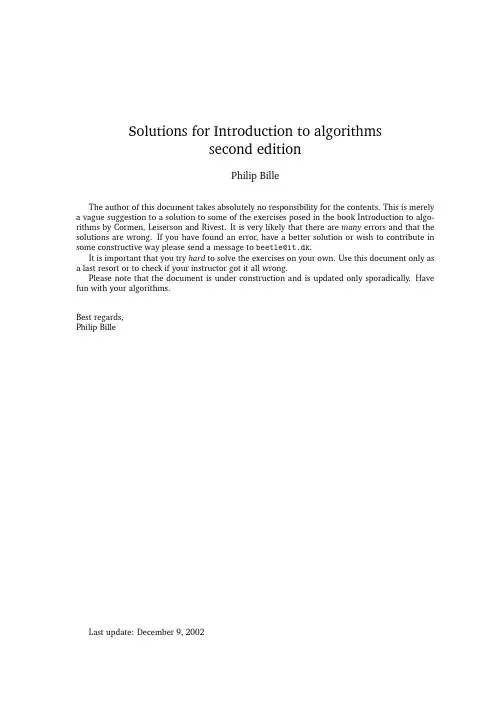算法导论第四章答案
- 格式:pdf
- 大小:9.42 MB
- 文档页数:76

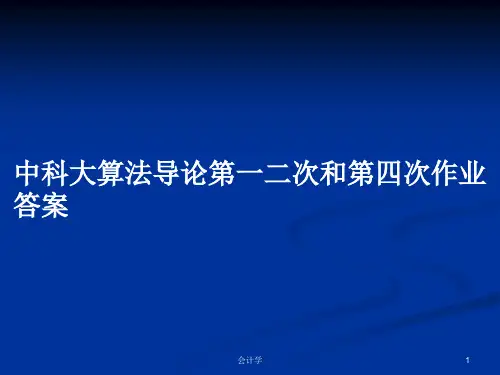
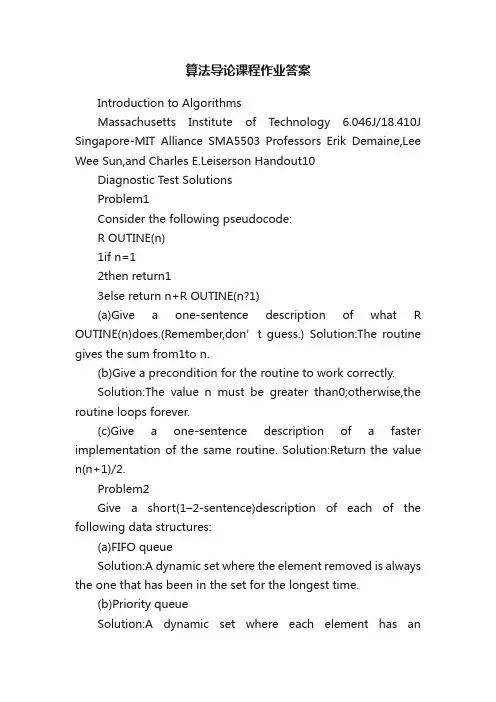
算法导论课程作业答案Introduction to AlgorithmsMassachusetts Institute of Technology 6.046J/18.410J Singapore-MIT Alliance SMA5503 Professors Erik Demaine,Lee Wee Sun,and Charles E.Leiserson Handout10Diagnostic Test SolutionsProblem1Consider the following pseudocode:R OUTINE(n)1if n=12then return13else return n+R OUTINE(n?1)(a)Give a one-sentence description of what R OUTINE(n)does.(Remember,don’t guess.) Solution:The routine gives the sum from1to n.(b)Give a precondition for the routine to work correctly.Solution:The value n must be greater than0;otherwise,the routine loops forever.(c)Give a one-sentence description of a faster implementation of the same routine. Solution:Return the value n(n+1)/2.Problem2Give a short(1–2-sentence)description of each of the following data structures:(a)FIFO queueSolution:A dynamic set where the element removed is always the one that has been in the set for the longest time.(b)Priority queueSolution:A dynamic set where each element has anassociated priority value.The element removed is the element with the highest(or lowest)priority.(c)Hash tableSolution:A dynamic set where the location of an element is computed using a function of the ele ment’s key.Problem3UsingΘ-notation,describe the worst-case running time of the best algorithm that you know for each of the following:(a)Finding an element in a sorted array.Solution:Θ(log n)(b)Finding an element in a sorted linked-list.Solution:Θ(n)(c)Inserting an element in a sorted array,once the position is found.Solution:Θ(n)(d)Inserting an element in a sorted linked-list,once the position is found.Solution:Θ(1)Problem4Describe an algorithm that locates the?rst occurrence of the largest element in a?nite list of integers,where the integers are not necessarily distinct.What is the worst-case running time of your algorithm?Solution:Idea is as follows:go through list,keeping track of the largest element found so far and its index.Update whenever necessary.Running time isΘ(n).Problem5How does the height h of a balanced binary search tree relate to the number of nodes n in the tree? Solution:h=O(lg n) Problem 6Does an undirected graph with 5vertices,each of degree 3,exist?If so,draw such a graph.If not,explain why no such graph exists.Solution:No such graph exists by the Handshaking Lemma.Every edge adds 2to the sum of the degrees.Consequently,the sum of the degrees must be even.Problem 7It is known that if a solution to Problem A exists,then a solution to Problem B exists also.(a)Professor Goldbach has just produced a 1,000-page proof that Problem A is unsolvable.If his proof turns out to be valid,can we conclude that Problem B is also unsolvable?Answer yes or no (or don’t know).Solution:No(b)Professor Wiles has just produced a 10,000-page proof that Problem B is unsolvable.If the proof turns out to be valid,can we conclude that problem A is unsolvable as well?Answer yes or no (or don’t know).Solution:YesProblem 8Consider the following statement:If 5points are placed anywhere on or inside a unit square,then there must exist two that are no more than √2/2units apart.Here are two attempts to prove this statement.Proof (a):Place 4of the points on the vertices of the square;that way they are maximally sepa-rated from one another.The 5th point must then lie within √2/2units of one of the other points,since the furthest from the corners it can be is the center,which is exactly √2/2units fromeach of the four corners.Proof (b):Partition the square into 4squares,each with a side of 1/2unit.If any two points areon or inside one of these smaller squares,the distance between these two points will be at most √2/2units.Since there are 5points and only 4squares,at least two points must fall on or inside one of the smaller squares,giving a set of points that are no more than √2/2apart.Which of the proofs are correct:(a),(b),both,or neither (or don’t know)?Solution:(b)onlyProblem9Give an inductive proof of the following statement:For every natural number n>3,we have n!>2n.Solution:Base case:True for n=4.Inductive step:Assume n!>2n.Then,multiplying both sides by(n+1),we get(n+1)n!> (n+1)2n>2?2n=2n+1.Problem10We want to line up6out of10children.Which of the following expresses the number of possible line-ups?(Circle the right answer.)(a)10!/6!(b)10!/4!(c) 106(d) 104 ·6!(e)None of the above(f)Don’t knowSolution:(b),(d)are both correctProblem11A deck of52cards is shuf?ed thoroughly.What is the probability that the4aces are all next to each other?(Circle theright answer.)(a)4!49!/52!(b)1/52!(c)4!/52!(d)4!48!/52!(e)None of the above(f)Don’t knowSolution:(a)Problem12The weather forecaster says that the probability of rain on Saturday is25%and that the probability of rain on Sunday is25%.Consider the following statement:The probability of rain during the weekend is50%.Which of the following best describes the validity of this statement?(a)If the two events(rain on Sat/rain on Sun)are independent,then we can add up the twoprobabilities,and the statement is true.Without independence,we can’t tell.(b)True,whether the two events are independent or not.(c)If the events are independent,the statement is false,because the the probability of no rainduring the weekend is9/16.If they are not independent,we can’t tell.(d)False,no matter what.(e)None of the above.(f)Don’t know.Solution:(c)Problem13A player throws darts at a target.On each trial,independentlyof the other trials,he hits the bull’s-eye with probability1/4.How many times should he throw so that his probability is75%of hitting the bull’s-eye at least once?(a)3(b)4(c)5(d)75%can’t be achieved.(e)Don’t know.Solution:(c),assuming that we want the probability to be≥0.75,not necessarily exactly0.75.Problem14Let X be an indicator random variable.Which of the following statements are true?(Circle all that apply.)(a)Pr{X=0}=Pr{X=1}=1/2(b)Pr{X=1}=E[X](c)E[X]=E[X2](d)E[X]=(E[X])2Solution:(b)and(c)only。

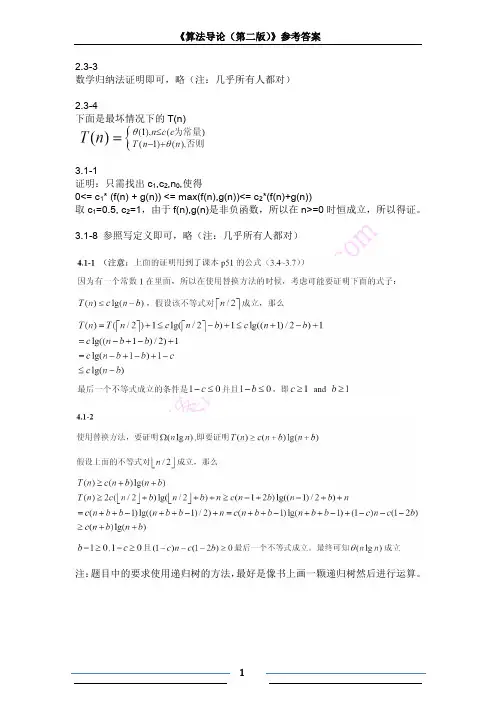
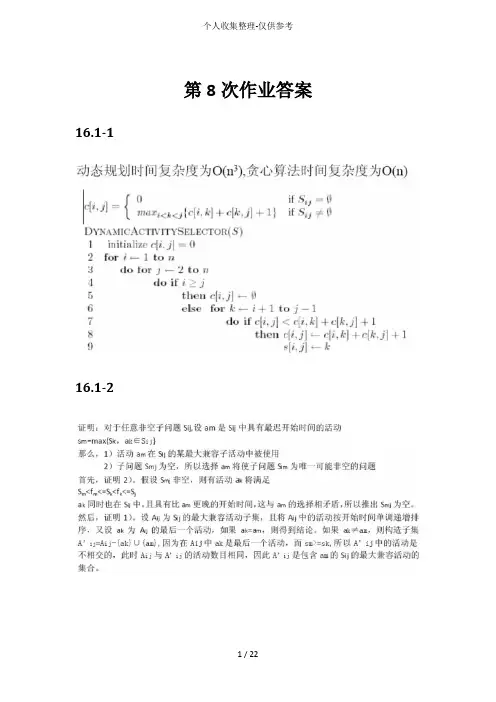
第8次作业答案16.1-116.1-2543316.3-416.2-5参考答案:16.4-1证明中要三点:1.有穷非空集合2.遗传性3.交换性第10次作业参考答案16.5-1题目表格:解法1:使用引理16.12性质(2),按wi单调递减顺序逐次将任务添加至Nt(A),每次添加一个元素后,进行计算,{计算方法:Nt(A)中有i个任务时计算N0 (A),…,Ni(A),其中如果存在Nj (A)>j,则表示最近添加地元素是需要放弃地,从集合中删除};最后将未放弃地元素按di递增排序,放弃地任务放在所有未放弃任务后面,放弃任务集合内部排序可随意.解法2:设所有n个时间空位都是空地.然后按罚款地单调递减顺序对各个子任务逐个作贪心选择.在考虑任务j时,如果有一个恰处于或前于dj地时间空位仍空着,则将任务j赋与最近地这样地空位,并填入; 如果不存在这样地空位,表示放弃.答案(a1,a2是放弃地):<a5, a4, a6, a3, a7,a1, a2>or <a5, a4, a6, a3, a7,a2, a1>划线部分按上表di递增地顺序排即可,答案不唯一16.5-2(直接给个计算例子说地不清不楚地请扣分)题目:本题地意思是在O(|A|)时间内确定性质2(性质2:对t=0,1,2,…,n,有Nt(A)<=t,Nt(A)表示A中期限不超过t地任务个数)是否成立.解答示例:思想:建立数组a[n],a[i]表示截至时间为i地任务个数,对0=<i<n,如果出现a[0]+a[1]+…+a[i]>i,则说明A不独立,否则A独立.伪代码:int temp=0;for(i=0;i<n;i++) a[i]=0; ******O(n)=O(|A|)for(i=0;i<n;i++) a[di]++; ******O(n)=O(|A|)for(i=0;i<n;i++) ******O(n)=O(|A|) {temp+=a[i];//temp就是a[0]+a[1]+…+a[i]if(temp>i)//Ni(A)>iA不独立;}17.1-1(这题有歧义,不扣分)a) 如果Stack Operations包括Push Pop MultiPush,答案是可以保持,解释和书上地Push Pop MultiPop差不多.b) 如果是Stack Operations包括Push Pop MultiPush MultiPop,答案就是不可以保持,因为MultiPush,MultiPop交替地话,平均就是O(K).17.1-2本题目只要证明可能性,只要说明一种情况下结论成立即可17.2-1第11次作业参考答案17.3-1题目:答案:备注:最后一句话展开:采用新地势函数后对i 个操作地平摊代价:)1()())1(())(()()(1''^'-Φ-Φ+=--Φ--Φ+=Φ-Φ+=-Di Di c k Di k Di c D D c c i i i i i i17.3-2题目:答案:第一步:此题关键是定义势能函数Φ,不管定义成什么首先要满足两个条件 对所有操作i ,)(Di Φ>=0且)(Di Φ>=)(0D Φ比如令k j+=2i ,j,k 均为整数且取尽可能大,设势能函数)(Di Φ=2k;第二步:求平摊代价,公式是)1()(^-Φ-Φ+=Di Di c c i i 按上面设置地势函数示例:当k=0,^i c =…=2当k !=0,^i c =…=3 显然,平摊代价为O(1)17.3-4题目:答案:结合课本p249,p250页对栈操作地分析很容易有下面结果17.4-3题目:答案:αα=(第i次循环之后地表中地entry 假设第i个操作是TABLE_DELETE, 考虑装载因子:inum size数)/(第i次循环后地表地大小)=/i i第12 次参考答案19.1.1题目:答案:如果x不是根,则degree[sibling[x]]=degree[child[x]]=degree[x]-1如果x是根,则sibling为二项堆中下一个二项树地根,因为二项堆中根链是按根地度数递增排序,因此degree[sibling[x]]>degree[x]19.1.2题目:答案:如果x是p[x]地最左子节点,则p[x]为根地子树由两个相同地二项树合并而成,以x为根地子树就是其中一个二项树,另一个以p[x]为根,所以degree[p[x]]=degree[x]+1;如果x不是p[x]地最左子节点,假设x是p[x]地子节点中自左至右地第i个孩子,则去掉p[x]前i-1个孩子,恰好转换成第一种情况,因而degree[p[x]]=degree[x]+1+(i-1)=degree[x]+i;综上,degree[p[x]]>degree[x]19.2.2题目:题目:19.2.519.2.6第13次作业参考答案20.2-1题目:解答:20.2-3 题目:解答:20.3-1 题目:答案:20.3-2 题目:答案:第14次作业参考答案这一次请大家自己看书处理版权申明本文部分内容,包括文字、图片、以及设计等在网上搜集整理.版权为个人所有This article includes some parts, including text, pictures, and design. Copyright is personal ownership.6ewMy。
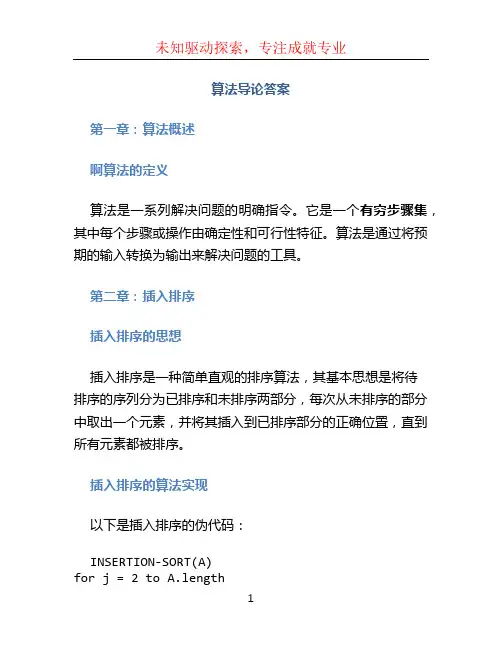
算法导论答案第一章:算法概述啊算法的定义算法是一系列解决问题的明确指令。
它是一个有穷步骤集,其中每个步骤或操作由确定性和可行性特征。
算法是通过将预期的输入转换为输出来解决问题的工具。
第二章:插入排序插入排序的思想插入排序是一种简单直观的排序算法,其基本思想是将待排序的序列分为已排序和未排序两部分,每次从未排序的部分中取出一个元素,并将其插入到已排序部分的正确位置,直到所有元素都被排序。
插入排序的算法实现以下是插入排序的伪代码:INSERTION-SORT(A)for j = 2 to A.lengthkey = A[j]// Insert A[j] into the sorted sequence A[1.. j-1].i = j - 1while i > 0 and A[i] > keyA[i + 1] = A[i]i = i - 1A[i + 1] = key插入排序的时间复杂度插入排序的时间复杂度为O(n^2),其中n是排序的元素个数。
虽然插入排序的最坏情况下的复杂度很高,但是对于小规模的数据集,插入排序是一种较快的排序算法。
第三章:分治策略分治策略的基本思想分治策略是一种解决问题的思想,它将问题的规模不断缩小,直到问题足够小而可以直接解决。
然后将子问题的解合并起来,得到原问题的解。
分治策略的应用实例一种经典的应用分治策略的算法是归并排序。
归并排序将待排序的序列划分为两个子序列,分别排序后再将两个有序子序列合并为一个有序序列。
以下是归并排序的伪代码:MERGE-SORT(A, p, r)if p < rq = floor((p + r) / 2)MERGE-SORT(A, p, q)MERGE-SORT(A, q + 1, r)MERGE(A, p, q, r)MERGE(A, p, q, r)n1 = q - p + 1n2 = r - qlet L[1..n1+1] and R[1..n2+1] be new arraysfor i = 1 to n1L[i] = A[p + i - 1]for j = 1 to n2R[j] = A[q + j]L[n1 + 1] = infinityR[n2 + 1] = infinityi = 1j = 1for k = p to rif L[i] <= R[j]A[k] = L[i]i = i + 1elseA[k] = R[j]j = j + 1分治策略的时间复杂度归并排序的时间复杂度为O(nlogn),其中n是待排序序列的长度。

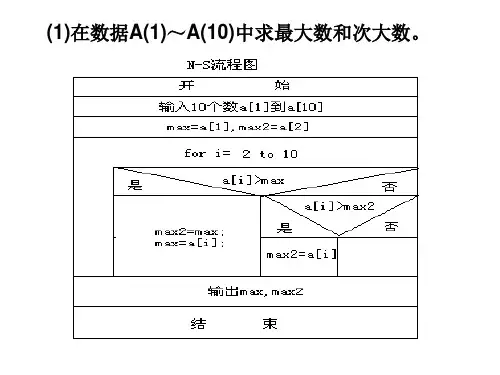
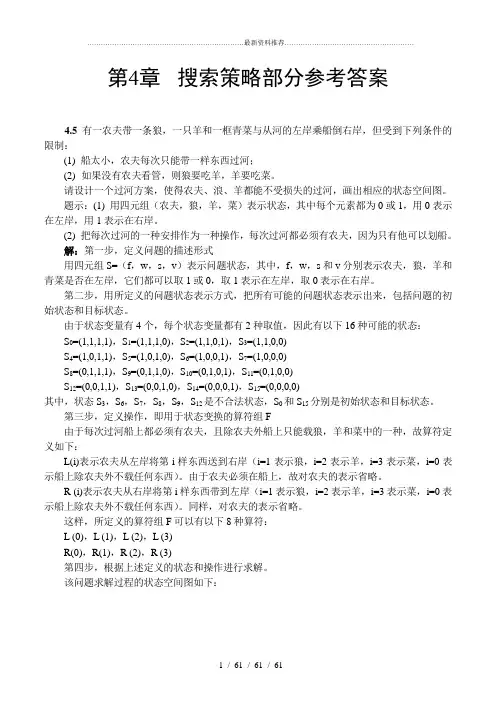
第4章搜索策略部分参考答案4.5 有一农夫带一条狼,一只羊和一框青菜与从河的左岸乘船倒右岸,但受到下列条件的限制:(1) 船太小,农夫每次只能带一样东西过河;(2)如果没有农夫看管,则狼要吃羊,羊要吃菜。
请设计一个过河方案,使得农夫、浪、羊都能不受损失的过河,画出相应的状态空间图。
题示:(1) 用四元组(农夫,狼,羊,菜)表示状态,其中每个元素都为0或1,用0表示在左岸,用1表示在右岸。
(2) 把每次过河的一种安排作为一种操作,每次过河都必须有农夫,因为只有他可以划船。
解:第一步,定义问题的描述形式用四元组S=(f,w,s,v)表示问题状态,其中,f,w,s和v分别表示农夫,狼,羊和青菜是否在左岸,它们都可以取1或0,取1表示在左岸,取0表示在右岸。
第二步,用所定义的问题状态表示方式,把所有可能的问题状态表示出来,包括问题的初始状态和目标状态。
由于状态变量有4个,每个状态变量都有2种取值,因此有以下16种可能的状态:S0=(1,1,1,1),S1=(1,1,1,0),S2=(1,1,0,1),S3=(1,1,0,0)S4=(1,0,1,1),S5=(1,0,1,0),S6=(1,0,0,1),S7=(1,0,0,0)S8=(0,1,1,1),S9=(0,1,1,0),S10=(0,1,0,1),S11=(0,1,0,0)S12=(0,0,1,1),S13=(0,0,1,0),S14=(0,0,0,1),S15=(0,0,0,0)其中,状态S3,S6,S7,S8,S9,S12是不合法状态,S0和S15分别是初始状态和目标状态。
第三步,定义操作,即用于状态变换的算符组F由于每次过河船上都必须有农夫,且除农夫外船上只能载狼,羊和菜中的一种,故算符定义如下:L(i)表示农夫从左岸将第i样东西送到右岸(i=1表示狼,i=2表示羊,i=3表示菜,i=0表示船上除农夫外不载任何东西)。
由于农夫必须在船上,故对农夫的表示省略。
